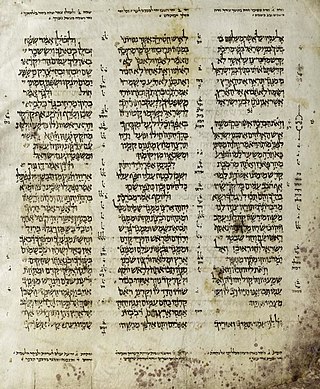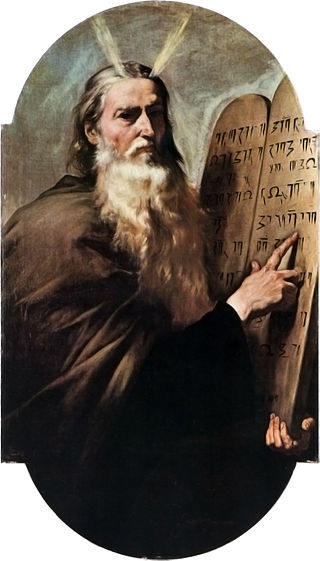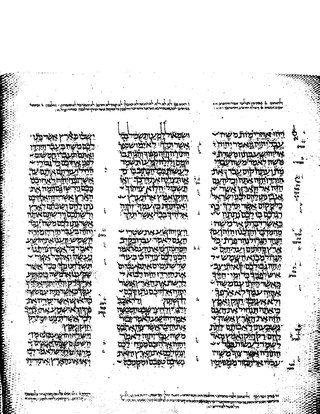Related Research Articles
The Book of Numbers is the fourth book of the Hebrew Bible and the fourth of five books of the Jewish Torah. The book has a long and complex history; its final form is possibly due to a Priestly redaction of a Yahwistic source made sometime in the early Persian period. The name of the book comes from the two censuses taken of the Israelites.

The Torah is the compilation of the first five books of the Hebrew Bible, namely the books of Genesis, Exodus, Leviticus, Numbers and Deuteronomy. It is known as the Pentateuch or the Five Books of Moses by Christians. It is also known as the Written Torah in Jewish tradition. If meant for liturgic purposes, it takes the form of a Torah scroll. If in bound book form, it is called Chumash, and is usually printed with the rabbinic commentaries.

For the Balaam Inscription, see the Deir Alla Inscription.
Sihon was an Amorite king mentioned in the Hebrew Bible, who refused to let the Israelites pass through his country.

Moab is the name of an ancient Levantine kingdom whose territory is today located in southern Jordan. The land is mountainous and lies alongside much of the eastern shore of the Dead Sea. The existence of the Kingdom of Moab is attested to by numerous archaeological findings, most notably the Mesha Stele, which describes the Moabite victory over an unnamed son of King Omri of Israel, an episode also noted in 2 Kings 3. The Moabite capital was Dibon. According to the Hebrew Bible, Moab was often in conflict with its Israelite neighbours to the west.

Balak was a king of Moab described in the Book of Numbers in the Hebrew Bible, where his dealings with the prophet Balaam are recounted. Balak tried to engage Balaam for the purpose of cursing the migrating Israelite community. On his journey to meet the princes of Moab, Balaam is stopped by an angel of the lord after beating his donkey. He tells the angel he will return home: "I have sinned, for I did not know that you stood against me on the road". The angel instructs Balaam to attend the meeting with the princes of Moab but to "say only what I tell you". According to Numbers 22:2, and Joshua 24:9, Balak was the son of Zippor.

Sefer haYashar is a medieval Hebrew midrash, also known as the Toledot Adam and Divrei haYamim heArukh. The Hebrew title "Sefer haYashar" might be translated as the "Book of the Correct Record", but it is known in English translation mostly as The Book of Jasher following English tradition. Its author is unknown.

The Law of Moses, also called the Mosaic Law, is the law said to have been revealed to Moses by God. The term primarily refers to the Torah or the first five books of the Hebrew Bible.
Aroer is a biblical town on the north bank of the River Arnon to the east of the Dead Sea, in present-day Jordan. The town was an ancient Moabite settlement, and is mentioned in the Bible.

Chukat, HuQath, Hukath, or Chukkas is the 39th weekly Torah portion in the annual Jewish cycle of Torah reading and the sixth in the Book of Numbers. The parashah sets out the laws of corpse contamination and purification with the water of lustration prepared with the Red Cow. It also reports the deaths of Miriam and Aaron, the failure of Moses at the Waters of Meribah, and the conquest of Arad, the Amorites, and Bashan. The parashah comprises Numbers 19:1–22:1. The parashah is the shortest weekly Torah portion in the Book of Numbers, and is made up of 4,670 Hebrew letters, 1,245 Hebrew words, 87 verses, and 159 lines in a Torah Scroll.

Devarim, Dvarim, or Debarim is the 44th weekly Torah portion in the annual Jewish cycle of Torah reading and the first in the Book of Deuteronomy. It comprises Deuteronomy 1:1–3:22. The parashah recounts how Moses appointed chiefs, the episode of the Twelve Spies, encounters with the Edomites and Ammonites, the conquest of Sihon and Og, and the assignment of land for the tribes of Reuben, Gad, and Manasseh.

V'Zot HaBerachah, VeZos HaBerachah, VeZot Haberakha, V'Zeis Habrocho, V'Zaus Haberocho, V'Zois Haberuchu, Wazoth Habborocho, or Zos Habrocho is the 54th and final weekly Torah portion in the annual Jewish cycle of Torah reading and the 11th and last in the Book of Deuteronomy. It constitutes Deuteronomy 33:1–34:12. The parashah sets out the farewell Blessing of Moses for the 12 Tribes of Israel and concludes with the death of Moses.

Mosaic authorship is the Judeo-Christian tradition that the Torah, the first five books of the Hebrew Bible/Old Testament, were dictated by God to Moses. The tradition probably began with the legalistic code of the Book of Deuteronomy and was then gradually extended until Moses, as the central character, came to be regarded not just as the mediator of law but as author of both laws and narrative.

Transjordan is an area of land in the Southern Levant lying east of the Jordan River valley. It is also alternatively called Gilead.

Numbers 31 is the 31st chapter of the Book of Numbers, the fourth book of the Pentateuch (Torah), the central part of the Hebrew Bible, a sacred text in Judaism and Christianity. Scholars such as Israel Knohl and Dennis T. Olson name this chapter the War against the Midianites.

The Plains of Moab are mentioned in three books of the Hebrew Bible as an area in Transjordan, stretching along the Jordan "across from Jericho", and more specifically "from Beth Jeshimoth to Abel Shittim". Here is the last Station of the Exodus and the place from which Moses climbs up on Mount Nebo "to the top of Pisgah", where he dies.

Joshua 24 is the twenty-fourth chapter of the Book of Joshua in the Hebrew Bible or in the Old Testament of the Christian Bible. According to Jewish tradition the book was attributed to the Joshua, with additions by the high priests Eleazar and Phinehas, but modern scholars view it as part of the Deuteronomistic History, which spans the books of Deuteronomy to 2 Kings, attributed to nationalistic and devotedly Yahwistic writers during the time of the reformer Judean king Josiah in 7th century BCE. This chapter records Joshua's final address to the people of Israel, that ends with a renewal of the covenant with YHWH, and the appendices of the book, a part of a section comprising Joshua 22:1–24:33 about the Israelites preparing for life in the land of Canaan.

Joshua 5 is the fifth chapter of the Book of Joshua in the Hebrew Bible or in the Old Testament of the Christian Bible. According to Jewish tradition, the book was attributed to the Joshua, with additions by the high priests Eleazar and Phinehas, but modern scholars view it as part of the Deuteronomistic History, which spans the books of Deuteronomy to 2 Kings, attributed to nationalistic and devotedly Yahwistic writers during the time of the reformer Judean king Josiah in 7th century BCE. This chapter focuses on the circumcision and Passover of the Israelites after crossing the Jordan River under the leadership of Joshua, a part of a section comprising Joshua 1:1–5:12 about the entry to the land of Canaan, and the meeting of Joshua with the Commander of the Lord's army near

Joshua 12 is the twelfth chapter of the Book of Joshua in the Hebrew Bible or in the Old Testament of the Christian Bible. According to Jewish tradition the book was attributed to the Joshua, with additions by the high priests Eleazar and Phinehas, but modern scholars view it as part of the Deuteronomistic History, which spans the books of Deuteronomy to 2 Kings, attributed to nationalistic and devotedly Yahwistic writers during the time of the reformer Judean king Josiah in 7th century BCE. This chapter records the list of kings defeated by the Israelites under the leadership of Moses and Joshua, a part of a section comprising Joshua 5:13–12:24 about the conquest of Canaan.

According to the Hebrew Bible, the Tribe of Reuben was one of the twelve tribes of Israel. Unlike the majority of the tribes, the land of Reuben, along with that of Gad and half of Manasseh, was on the eastern side of the Jordan and shared a border with Moab. According to the biblical narrative, the Tribe of Reuben descended from Reuben, the eldest son of the patriarch Jacob. Reuben, along with nine other tribes, is reckoned by the Bible as part of the northern kingdom of Israel, and disappears from history with the demise of that kingdom in c. 723 BC.
References
- ↑ Student, Gil. On the Authorship of the Torah. (Aishdas.org) The author writes: "So far, we have seen the talmudic and midrashic evidence that the forefathers, including Moshe, wrote books other than the Torah that were maintained and studied. However, there is also much internal evidence that there were other books written. Consider the following verses," after which the author cites as examples of lost books Exodus 17:14 (words written in remembrance of the destruction of Amalek), Exodus 24:7 (Book of the Covenant), Numbers 11:26 (recorded ones), Numbers 21:14 (Book of the Wars of the LORD), and Numbers 33:2 (Journeys).
- ↑ Numbers 21:13–14
- ↑ Book of Jasher 90:48
- ↑ "Book of Wars of the Lord - Encyclopedia of The Bible - Bible Gateway". www.biblegateway.com. Retrieved 2023-11-15.
- ↑ Exodus 17:14